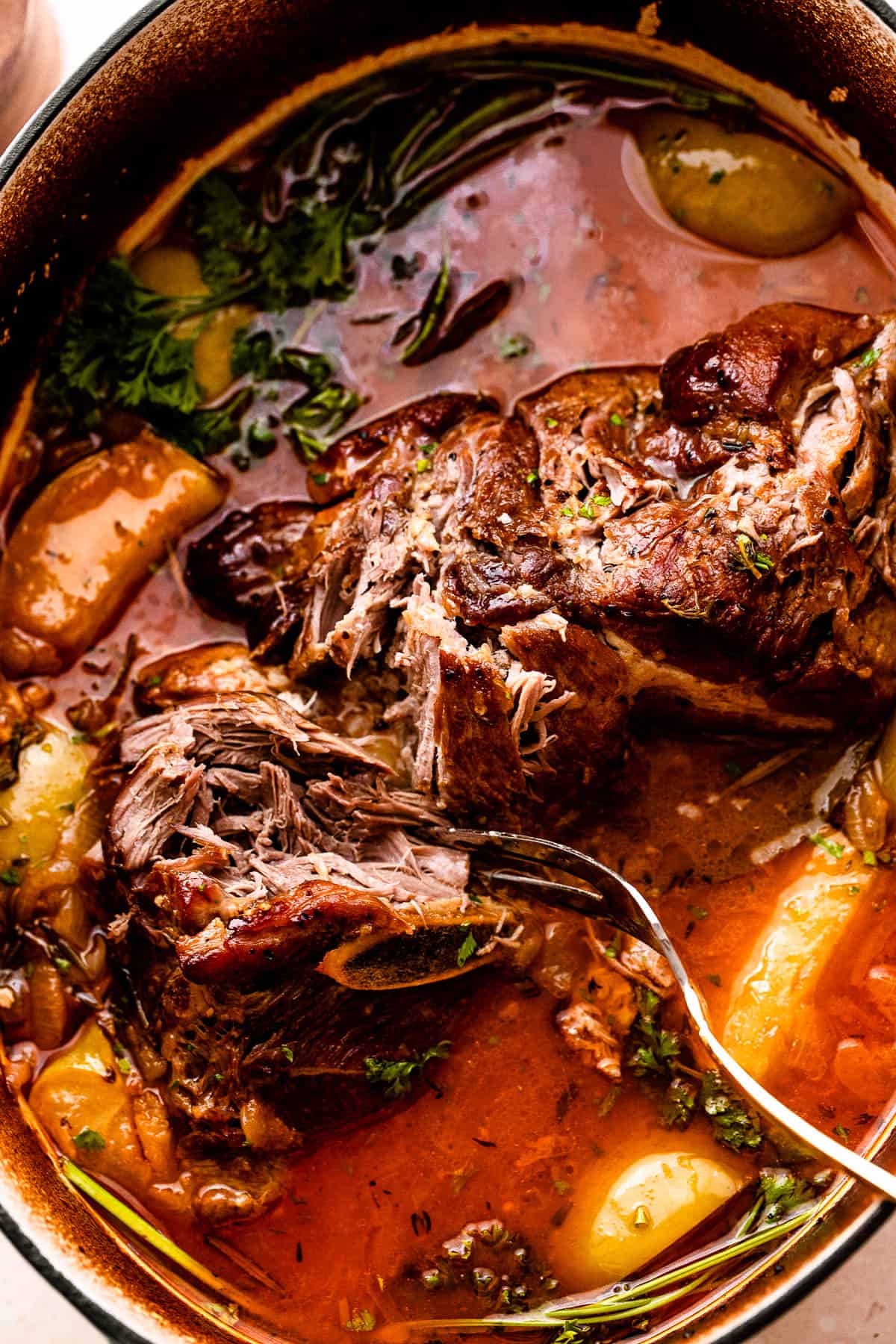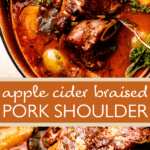This post may contain affiliate links. Please read our disclosure policy.
This Braised Pork Shoulder recipe is an easy and beautiful autumn main course! Made with unfiltered apple cider, Granny smith apples, onions, garlic, and white wine, the flavors are out of this world—and so perfectly cozy.

When you think of a braised roast, you may immediately think of beef, but in this recipe, we’re making pork roast, and let me tell you, this apple cider braised pork shoulder might just become your new favorite! Made with fresh garlic, lots of sliced onions, and seasonal apple cider, this recipe is full of the flavors of fall. It’s a great main course for a special occasion or just a Sunday dinner.
Although this recipe has a lot of gourmet flavor, it’s very simple to make. Braising is an easy technique that anyone can do, and it turns pork shoulder – and other cuts of meat – into tender, fall-apart masterpieces.
Why I Love This Braised Pork Shoulder Recipe
- Delicious & Tender: The slow braising technique ensures every bite of the pork shoulder is juicy and falls apart with minimal effort.
- Rich Flavor: With the combination of white wine, apple cider, and aromatic herbs, this dish offers all the flavors, ranging from sweet and tangy to savory and herby.
- Minimal Effort, Maximum Reward: While the braising process is lengthy, the hands-on time is quite limited. Once everything is in the pot, the oven does the heavy lifting, producing a restaurant-quality dish in the comfort of your own kitchen.
- Impressive Presentation: The final dish not only tastes great but also looks fantastic on a plate, making this pork shoulder recipe perfect for Holiday dinners or when you want to impress your dinner guests.

Ingredients You’ll Need
To make this easy braised pork shoulder recipe, you’ll need a mix of pantry ingredients and fresh items that you can easily pick up at the grocery store. I’ve included some notes and substitutions below, but for the full recipe, please scroll down to the recipe card.
- Pork Roast: You will need a 3-pound pork shoulder roast. Don’t use a pork loin or pork belly—keep that for a porchetta recipe.
- Salt and Pepper: A simple seasoning that will enhance the flavors of the pork.
- Olive Oil: For browning the pork roast before you braise it. Any neutral cooking oil can be used.
- Onions: Thinly sliced onions give this roast an especially luscious flavor during the slow cooking process.
- Fresh Garlic: Mince or press 6 cloves of garlic.
- White Wine: You’ll need ¼ cup of a good dry white wine. If you don’t want to use wine, you can omit it and use additional chicken broth, but the flavor won’t be quite as deep and developed.
- Fresh Thyme and Fresh Rosemary: I suggest using a tablespoon of each. If you only have dried rosemary and dried thyme, use 1 teaspoon of each.
- Paprika: Classic smoked paprika brings a pleasant, barbecue-ish note to the dish.
- Cider: In this braised pork shoulder recipe, I use unfiltered apple cider. If you can’t find it, try using apple juice with no added sugar.
- Chicken Broth: Use any chicken or veggie broth that you like.
- Apples: Core and quarter two granny smith apples, or another kind of tart apple.
- Chopped Fresh Parsley: For garnishing the finished pork roast.
Is pork shoulder the same as pork butt?
Technically, pork shoulder and pork butt are from the shoulder of the pig. Pork butt, also known as Boston butt, is above the shoulder blades, while pork shoulder roasts come from lower down on the shoulder. Both cuts are tougher cuts naturally. That’s why they also tend to be more affordable (hey hey!).
Pork shoulder, like other tough cuts, benefits amazingly from a long, moist cooking process, like braising. That’s because a long, slow cooking time breaks down the toughness in the meat, leaving pork shoulder roasts tender, juicy, and super flavorful!
How to Make Braised Pork Shoulder
The Dutch oven is my secret weapon for making this easy roast. It’s a great tool because you can brown the pork shoulder on the stovetop, and then cover it with the lid, and put it right into the oven. After that, the same pot goes right back on the stove to thicken the sauce.


- Prep the Oven and Brown the Pork Roast. First, preheat your oven to 400˚F. Then, pat the pork dry using paper towels. Season it generously with salt and pepper. After that, heat the oil in your Dutch oven over medium-high heat, and brown the pork for about five minutes on each side.
- Make the Braising Sauce. Take the pork roast out of the pot, and set it aside while you cook the onions and garlic. Once the onions are soft, splash the wine into the pot and use a wooden spoon to scrape up any browned bits. Next, add the herbs to the pot, along with the broth and cider.
- Braise the Pork. Carefully place the pork roast back into the pot and bring the liquid to a boil. Next, turn off the heat and cover the pot with a tight-fitting lid. Finally, place the pot in the oven, reduce the temperature to 350˚F and cook for 2 hours.
- Rest the Pork Shoulder and Reduce the Sauce. After two hours, uncover the pot and add in the apples. Then replace the lid, and cook for another half hour or until the pork is done.
- Remove the pork shoulder from the pot and transfer it to a cutting board; let rest for 10 minutes. While it rests, set the pot over high heat and bring the braising liquid to a boil, cooking it for several minutes until it thickens.
- Serve. Slice the braised pork shoulder and serve it with the onions, apples, and sauce.
Slow Cooker Method
For a delicious slow cooker pork roast, start by patting the pork shoulder dry and seasoning it generously with salt and pepper. Optionally, brown the pork in a skillet with oil for added flavor. In the same skillet, sauté chopped onions and minced garlic until soft, then deglaze with wine and stir in herbs, broth, and cider. Transfer the pork to the slow cooker, pour the sauce over it, and cook on LOW for 8 hours, adding chopped apples in the last 30 minutes. Once done, let the pork rest before slicing and serve it with the onions, apples, and sauce for a comforting meal.

Recipe Tips
- Choosing pork: When selecting a pork shoulder, look for one with good marbling. The fat will render down during the cooking process, adding flavor and ensuring a tender result.
- Dutch oven alternatives: You can brown the pork and make the sauce in a skillet, and then braise it in almost any baking dish. It just needs to have room for the liquid, and a tight-fitting ovenproof lid. No lid? Cover the dish with aluminum foil.
- Cube the pork: If you like, you can make this recipe with cubes of pork shoulder. That makes for easier portioning and serving, and cubes of pork will cook faster than a whole roast.
- Herb variations: While thyme and rosemary are recommended, you can also experiment with other herbs like sage, which pairs wonderfully with pork and apples.
- Strain the sauce (optional): If you prefer a smoother sauce, you can strain it after reducing it to remove the onions and any remaining herbs.
- Add cream: To make the gravy creamy, whisk in ¼ to ½ cup of heavy cream as it boils.
Serving Suggestions
After a long, flavorful braise, this pork shoulder recipe is so tender and juicy I could devour it as-is, but a side of my easy sauteed broccolini brings a nice touch of green to the table! Also, a pan of honey roasted butternut squash is the perfect savory-sweet seasonal pairing with apple cider braised pork.
Consider serving the roast over a bed of creamy mashed potatoes or buttery mashed cauliflower to soak up the delicious sauce. A veggie salad like this spring vegetable potato salad pairs nicely with the rich pork roast. I love to make a big dish of baked macaroni and feta when it’s cold out. The warm, inviting aroma puts everyone in a good mood—it’s classic comfort food!

How to Store and Reheat Leftovers
- To refrigerate leftover pork shoulder, place in shallow containers with the gravy, and store for up to three days.
- If you want to freeze your leftovers, place the pork in the gravy and freeze in freezer bags or airtight storage containers for up to two months.
- To reheat, thaw overnight in the refrigerator (if frozen). Then place leftovers in a covered skillet or saucepan over low heat until heated through.
More Pork Recipes
- Char Siu
- Instant Pot Pork Chops with Creamy Ranch Sauce
- Quick Pork Carnitas Tacos
- Grilled Pork Tenderloin
- Pork Loin Roast
- Crock Pot Pork Loin
- Slow Cooker Pork Loin Chile Verde
Pin this now to find it later
Pin It
Braised Pork Shoulder
Ingredients
- 3 pounds pork shoulder roast
- Kosher salt and fresh ground black pepper, to taste
- 2 tablespoons olive oil
- 4 yellow onions, thinly sliced
- 6 cloves garlic, minced
- ¼ cup dry white wine
- 1 tablespoon fresh thyme, or use 1 teaspoon dried thyme
- 1 tablespoon fresh chopped rosemary leaves, or use 1 teaspoon crushed dried rosemary
- 1 teaspoon smoked paprika
- 1½ cups Apple Cider, NOT Apple Cider Vinegar
- 1½ cups low sodium chicken broth
- 2 bay leaves
- 2 granny smith apples, cored and quartered
Instructions
- Preheat the oven to 400˚F.
- Pat dry the pork with paper towels and season all over with kosher salt and black pepper.
- Heat the oil in a large oven-safe Dutch oven set over medium-high heat. To the heated oil, add the pork and brown it on all sides; about 5 minutes per side.
- Remove the pork from the pot and set it aside.
- Add onions to the pot and cook over medium heat for about 4 to 5 minutes, stirring often, until softened. Stir in the garlic and cook for 20 seconds.
- Deglaze the pot with the wine, scraping up all the browned bits from the bottom of the pot. Then, stir in the thyme, rosemary, and paprika.
- Add the pork back to the pot. Add in the apple cider, chicken broth, and bay leaves; bring the mixture to a boil.
- Cover the pot with a tight-fitting lid and transfer the pork to the oven.
- Reduce the oven temperature to 350˚F and cook for 2 hours.
- Remove the lid from the pot and drop in the apples. Cover and continue to cook in the oven for 30 minutes or until the internal temperature of the pork registers at least 145˚F and up to 200˚F.
- Remove from the oven and return the pot to the stovetop. Remove the pork from the pot and transfer it to a cutting board; let it rest for 10 minutes.
- In the meantime, set the pot over high heat and bring it to a boil; cook for a couple minutes or until sauce is slightly reduced and thickened.
- Cut the pork and serve it with the sauce, onions, and apples.
Notes
- Choosing the Pork: When selecting a pork shoulder, look for one with good marbling.
- Browning is Key: Don’t rush the browning step. Creating a good sear on the pork shoulder enhances the flavor and gives the dish a richer color.
- Deglazing the Pot: Make sure to scrape up all the browned bits from the bottom of the pot after adding the wine.
- Internal Temperature: While pork is safe to eat at 145˚F, you will want to cook a pork shoulder longer than that to allow the pork to reach its sweet spot. The best internal temperature for pork shoulder is about 170˚F to 190˚F, but for pulled pork, the best temp is around 205˚F.
- Resting Time: Always allow your pork to rest before slicing. This ensures the juices redistribute throughout the meat, keeping it juicy.
- Strain the Sauce: If you prefer a smoother sauce, you can strain it after reducing it to remove the onions and any remaining herbs.
- Herbs: While thyme and rosemary are recommended, you can also experiment with other herbs like sage, which pairs wonderfully with pork and apples.
- Serving Suggestion: Consider serving the pork over a bed of creamy mashed potatoes or buttery egg noodles to soak up the delicious sauce.
Nutrition
Nutritional info is an estimate and provided as courtesy. Values may vary according to the ingredients and tools used. Please use your preferred nutritional calculator for more detailed info.










I made this recipe exactly as written and it was delicious ! My grown son is a picky eater and he had two huge helpings as did I. The leftovers are going to become pork hoagies with Bar B Que! This is definitely a keeper.
– this made one of the best sauces I ever made/had
– I did a quick dry rub brine, grilled the pork and then followed the recipe
– at the end, I did a coarse shred of the pork and added two more cups each of cider and chicken broth for extra sauce
– I strained the sauce and the next time I make it, I’m going to reserve half an onion and half a granny smith to add back for crisp bites
– thanks for posting!
I have made this twice. The first was a trial run before dinner club. Delicious. All raved about pork. Very tender. The smallest sizes of bone in pork shoulder I could find were around 6 lbs. I made 1 in dutch oven and 1 in crockpot as I was feeding a large group. Will be making this often.Used a mandolin to slice onions. Lots of prep work but then just sit back and enjoy the end result and in my case – Enjoyed the party
I made this for some friends and we all loved it! I would say to allow extra time in the oven for the pork to get really tender and add the apples for the last 15 minutes. I just let it all rest in the Dutch oven for 10 minutes and served everything together without doing the sauce reduction step. Served over frozen Trader Joes mashed potatoes. easy fall dinner that everyone devoured.
That’s great! I’m very glad you and your friends enjoyed it! Thank YOU! 🙂
So, this recipe is pretty good, but if I had made it exactly as written it wouldn’t have turned out. First of all, if you want the meat to fall apart (especially if your shoulder roast has a bone) it will have to cook A LOT longer than 2.5 hrs. I would say at least 4 hrs to do it right. Secondly, the sauce will not thicken on its own simply by heating it up on the stove. I used a little flour to make a slurry and then added a little heavy cream at the end because, why the heck not? I also added some slices of red pear because I found some beautiful ones while I was grocery shopping. Served it over roasted gold potatoes. Overall, I like this recipe, but I did modify it some.
Hi! I plan on making this this weekend. Would it be ok to use a boneless pork butt? Would that change anything on the cooking time? Thanks in advance.
Yes, that is definitely okay, but cook it until the pork’s internal temperature registers to (at least 145˚F) but up to 200˚F or until fall-apart tender.
Cooked an 8.5 lb shoulder, cut in half. One of the best recipes I have tried in a long time!!
Hi,
I plan on doubling the recipe to serve 12 people. Is the cooking time the same? thanks in advance.
Hi!
Doubled recipes do not require double the cooking time, but the cooking time may need to be extended. Start checking for doneness at the time indicated in this recipe, then check about every 5 minutes afterward until it’s done. A pork shoulder should be cooked to at least 170°F, (btw, pork is safe to eat at 145˚F) but not beyond 210°F, to avoid drying it out.
This is so good, I don’t know what to do with my life now that it’s gone. Excellent recipe!
Apple Cider Braised Pork Shoulder Review
Easily a five-star recipe, delicious and tender, and oh what a sauce!
I will add the fifth star when I work out the problem I encountered.
After the first two hours in the oven, when I added the apples, I decided to check the temperature of the roast. It was already at 165°. I checked at a few more points throughout the roast. All other temperatures were higher still. Therefore, I removed the roast and moved onto finishing the sauce. Is the internal temperature really supposed to be 145°?
I suspect it has to do with multiplying the ingredients. I had a 5½ lb bone-in shoulder. Doubling the ingredients would have been insane, so I increased it by 1½. But I don’t have a larger Dutch oven. The fluid level was likely too high.
Another possibility is that with a bone-in shoulder, the bone conducted heat into the meat faster. In your recipe you may have been using a 3 lb boneless shoulder, though the picture shows otherwise.
I hope you get to read this. I would love your input. I really loved the recipe and intend to try it again next month.
Thank you,
Boh